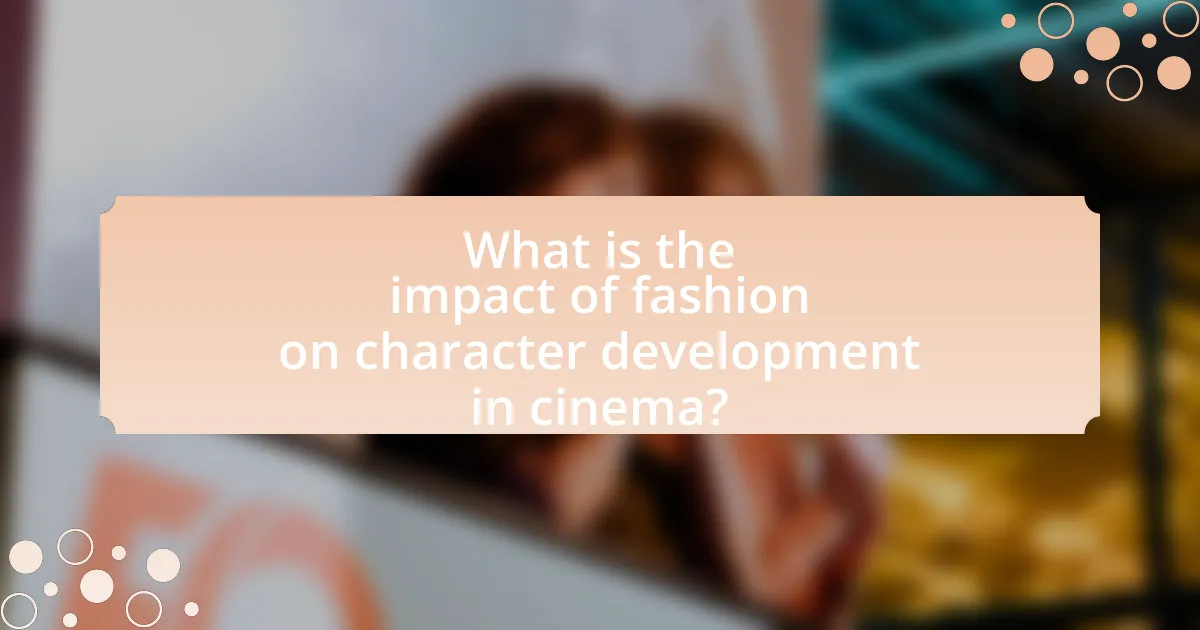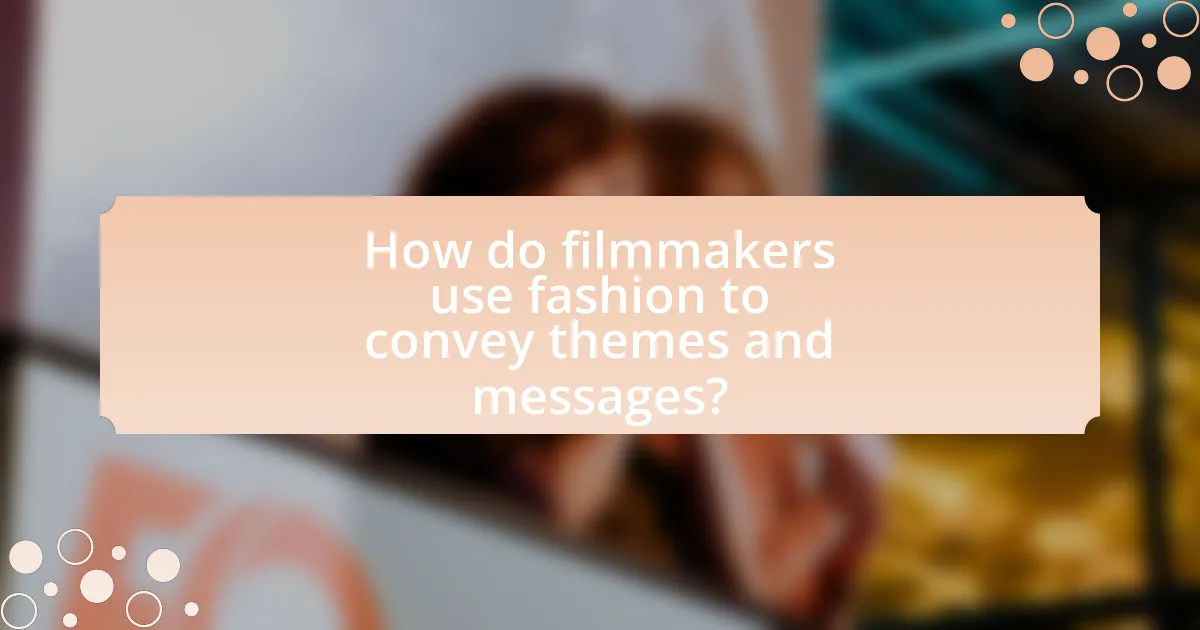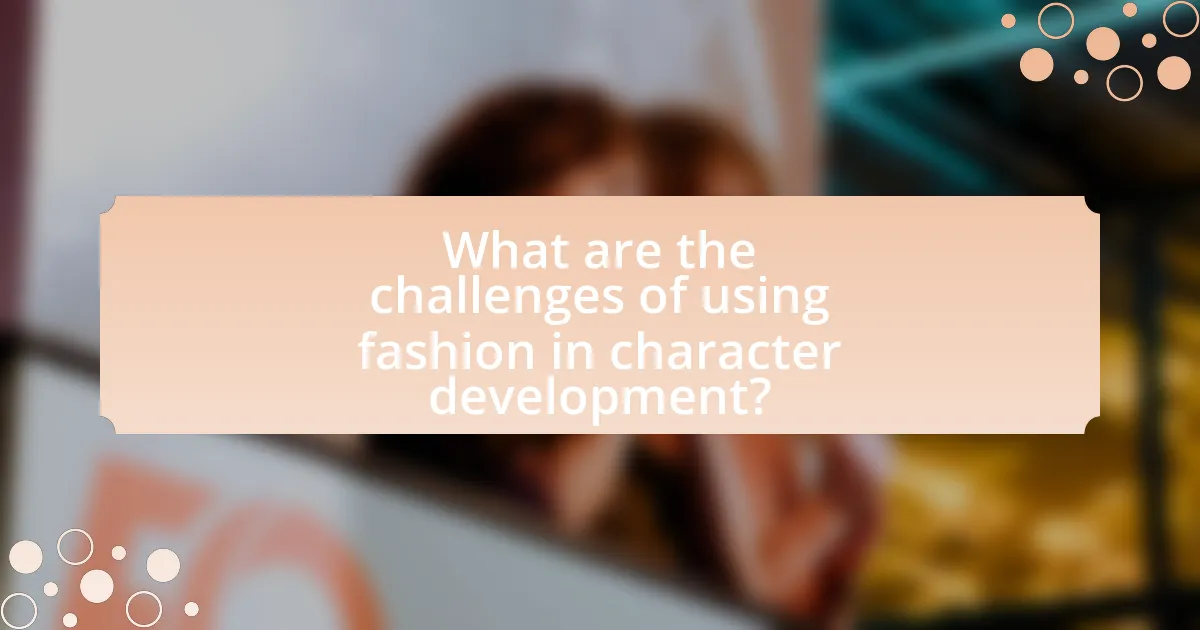The article examines the significant impact of fashion on character development in cinema, highlighting how costumes visually convey personality traits, social status, and emotional states. It discusses the role of fashion in shaping audience perception, enhancing emotional connections, and reflecting character journeys and transformations. Additionally, the article explores how filmmakers use fashion as a storytelling tool to convey themes and messages, establish setting and time periods, and enhance character relationships. It also addresses the challenges and best practices filmmakers should consider when integrating fashion into character portrayal to ensure authenticity and depth.

What is the impact of fashion on character development in cinema?
Fashion significantly impacts character development in cinema by visually conveying personality traits, social status, and emotional states. Costumes and clothing choices serve as non-verbal cues that help audiences understand characters’ motivations and transformations throughout the narrative. For instance, in films like “The Devil Wears Prada,” the protagonist’s evolution is mirrored by her changing wardrobe, reflecting her journey from an insecure individual to a confident professional. This visual storytelling is supported by research from the Journal of Fashion Technology & Textile Engineering, which highlights how attire influences audience perception and character relatability. Thus, fashion is a crucial tool in shaping and enhancing character arcs in cinematic storytelling.
How does fashion influence audience perception of characters?
Fashion significantly influences audience perception of characters by visually conveying their personality, status, and emotional state. For instance, a character dressed in high-end designer clothing may be perceived as wealthy and sophisticated, while a character in tattered clothing might evoke sympathy or represent struggle. Research indicates that clothing can affect viewers’ interpretations of a character’s motives and intentions; a study published in the Journal of Experimental Social Psychology found that participants judged characters based on their attire, associating specific clothing styles with traits such as competence or trustworthiness. Thus, fashion serves as a powerful tool in shaping how audiences relate to and understand characters in cinema.
What visual cues do costumes provide about a character’s personality?
Costumes provide visual cues that reveal a character’s personality through color, style, and accessories. For instance, bright colors often indicate a cheerful or extroverted personality, while darker tones may suggest mystery or introversion. The style of clothing, such as formal attire versus casual wear, can signify a character’s social status or attitude towards life. Accessories, like jewelry or hats, can further enhance personality traits, indicating wealth, creativity, or eccentricity. Research in film studies shows that costume design significantly influences audience perception of characters, as evidenced by studies analyzing character reception in various cinematic contexts.
How does fashion contribute to the emotional connection between the audience and characters?
Fashion significantly contributes to the emotional connection between the audience and characters by visually representing their personalities, social status, and emotional states. Through specific clothing choices, filmmakers can convey a character’s journey, struggles, and transformations, allowing the audience to empathize with their experiences. For example, in films like “The Devil Wears Prada,” the protagonist’s evolving wardrobe reflects her internal conflict and growth, making her relatable to viewers. This visual storytelling technique enhances the audience’s understanding of characters, fostering a deeper emotional investment in their narratives.
Why is fashion considered a storytelling tool in film?
Fashion is considered a storytelling tool in film because it visually conveys character traits, emotions, and narrative themes. Through costume design, filmmakers can establish a character’s social status, personality, and transformation over time, enhancing the audience’s understanding of the story. For example, in “The Great Gatsby,” the opulent fashion choices reflect the characters’ wealth and the era’s social dynamics, reinforcing the film’s themes of aspiration and disillusionment. This use of fashion as a narrative device allows for deeper character development and engagement with the audience.
How do costume choices reflect a character’s journey or transformation?
Costume choices reflect a character’s journey or transformation by visually representing their emotional and psychological changes throughout a narrative. For instance, in films like “The Wizard of Oz,” Dorothy’s transition from a simple blue gingham dress to a more sophisticated outfit symbolizes her growth and newfound confidence as she navigates a fantastical world. This visual evolution is crucial as it allows the audience to perceive the character’s development without explicit dialogue. Additionally, research in film studies indicates that costume design can serve as a narrative device, enhancing storytelling by aligning visual elements with character arcs, thereby reinforcing the connection between appearance and identity transformation.
What role does fashion play in establishing the setting and time period of a film?
Fashion serves a crucial role in establishing the setting and time period of a film by visually conveying cultural, social, and historical contexts. Costumes reflect the era’s trends, societal norms, and character backgrounds, helping audiences quickly identify the time frame and location of the narrative. For instance, films set in the 1920s often feature flapper dresses and cloche hats, which are emblematic of that decade’s fashion, while period dramas like “Pride and Prejudice” utilize Regency-era attire to immerse viewers in the early 19th century. This visual representation not only enhances authenticity but also aids in character development, as clothing choices can signify class, personality, and transformation throughout the storyline.
In what ways does fashion enhance character relationships in cinema?
Fashion enhances character relationships in cinema by visually representing their social status, personality traits, and emotional states. For instance, contrasting outfits can signify conflict or tension between characters, while coordinated styles may indicate unity or intimacy. In films like “The Devil Wears Prada,” the protagonist’s evolving wardrobe reflects her changing relationships and status, illustrating how fashion can symbolize character development and interpersonal dynamics. Additionally, specific fashion choices can evoke cultural or historical contexts, further enriching the narrative and character interactions.
How do contrasting styles between characters signify conflict or harmony?
Contrasting styles between characters signify conflict or harmony by visually representing their differing values, backgrounds, and motivations. For instance, in films like “The Devil Wears Prada,” the stark contrast between Andy’s casual attire and Miranda’s high-fashion wardrobe highlights their opposing worldviews, creating tension and illustrating class differences. This visual disparity not only emphasizes conflict but also serves as a narrative device to explore character development and transformation. In contrast, characters with complementary styles, such as in “Pride and Prejudice,” can signify harmony and shared values, reinforcing their connection and mutual understanding. Thus, fashion serves as a powerful tool in cinema to convey the dynamics of character relationships.
What are examples of fashion choices that symbolize character dynamics?
Fashion choices that symbolize character dynamics include the use of color, style, and accessories to reflect personality traits and relationships. For instance, in “The Devil Wears Prada,” the protagonist’s transition from casual clothing to high-fashion outfits signifies her evolution from an insecure assistant to a confident fashionista, illustrating her character development and changing dynamics with her boss. Similarly, in “Clueless,” Cher’s use of designer outfits showcases her social status and confidence, while her friend Tai’s more casual attire represents her outsider status, highlighting their contrasting character arcs. These fashion choices serve as visual cues that enhance the narrative and deepen audience understanding of character relationships and growth.

How do filmmakers use fashion to convey themes and messages?
Filmmakers use fashion to convey themes and messages by strategically selecting costumes that reflect characters’ identities, social status, and emotional states. For instance, in “The Great Gatsby,” the opulent fashion of the 1920s symbolizes wealth and excess, reinforcing themes of the American Dream and social stratification. Additionally, in films like “Black Panther,” the use of traditional African attire juxtaposed with modern elements communicates cultural pride and the theme of identity. Such choices are not arbitrary; they are grounded in historical and cultural contexts that enhance narrative depth and audience understanding.
What themes are commonly represented through fashion in films?
Fashion in films commonly represents themes such as identity, social status, and transformation. These themes are illustrated through character attire that reflects their personal journeys, societal roles, and changes throughout the narrative. For instance, in “The Devil Wears Prada,” the protagonist’s evolution from a frumpy intern to a stylish fashionista symbolizes her transformation and growing confidence, highlighting the theme of identity. Similarly, in “Clueless,” fashion is used to depict social status and class distinctions among characters, reinforcing the theme of societal hierarchy. These examples demonstrate how fashion serves as a visual narrative tool that enhances character development and thematic depth in cinema.
How does fashion reflect societal norms and cultural contexts in cinema?
Fashion in cinema serves as a visual representation of societal norms and cultural contexts, illustrating the values, beliefs, and social structures of the time. For instance, the clothing styles in films like “The Great Gatsby” reflect the opulence and social stratification of the 1920s, showcasing how fashion can signify wealth and status. Additionally, films such as “Black Panther” highlight cultural heritage through traditional African attire, emphasizing the importance of identity and representation in contemporary society. These examples demonstrate that fashion not only enhances character development but also acts as a narrative device that communicates cultural and societal messages, reinforcing the connection between visual aesthetics and the socio-cultural landscape.
What are some iconic films that use fashion to convey deeper messages?
Iconic films that use fashion to convey deeper messages include “The Devil Wears Prada,” “Breakfast at Tiffany’s,” and “A Single Man.” In “The Devil Wears Prada,” the protagonist’s transformation through fashion symbolizes her journey from authenticity to conformity in the high-stakes fashion industry. “Breakfast at Tiffany’s” features Holly Golightly’s iconic style, which reflects her complex identity and societal aspirations. In “A Single Man,” the meticulous wardrobe of the main character, George Falconer, illustrates his emotional state and the impact of loss. Each film employs fashion not merely as aesthetic but as a narrative device that deepens character development and thematic exploration.
How does the evolution of fashion in cinema mirror real-world trends?
The evolution of fashion in cinema mirrors real-world trends by reflecting societal changes, cultural movements, and technological advancements. For instance, the flapper dresses of the 1920s in films like “The Great Gatsby” showcased the liberation of women during that era, paralleling the real-world women’s suffrage movement. Similarly, the rise of punk fashion in the 1970s, as seen in movies like “Sid and Nancy,” echoed the rebellious spirit of youth culture and anti-establishment sentiments prevalent at the time. Additionally, contemporary films often incorporate sustainable fashion, aligning with the growing global emphasis on environmental consciousness. This correlation between cinematic fashion and real-world trends illustrates how filmmakers use clothing to comment on and influence societal norms and values.
What historical events have influenced fashion choices in films?
Historical events such as World War II, the Civil Rights Movement, and the rise of the feminist movement have significantly influenced fashion choices in films. For instance, during World War II, fabric rationing led to the popularity of more practical and utilitarian styles, which were reflected in films of that era, showcasing characters in functional attire. The Civil Rights Movement of the 1960s brought about a shift towards bold colors and patterns, symbolizing empowerment and cultural identity, which filmmakers incorporated into character wardrobes to reflect societal changes. Additionally, the feminist movement in the 1970s introduced more androgynous styles and professional attire for women, influencing films to portray female characters in a more progressive light, aligning with the evolving gender roles of the time. These historical contexts shaped not only the aesthetics of film fashion but also the underlying narratives and character development within cinema.
How do filmmakers adapt contemporary fashion trends to enhance storytelling?
Filmmakers adapt contemporary fashion trends to enhance storytelling by using clothing to reflect characters’ personalities, social status, and emotional states. For instance, in films like “The Devil Wears Prada,” the protagonist’s evolving wardrobe symbolizes her transformation from an insecure intern to a confident fashionista, illustrating character development through visual cues. Additionally, filmmakers often collaborate with fashion designers to create authentic looks that resonate with current societal trends, thereby grounding the narrative in a relatable context. This approach not only enriches the visual storytelling but also engages audiences by making characters more identifiable and their journeys more impactful.

What are the challenges of using fashion in character development?
Using fashion in character development presents challenges such as the risk of stereotyping, misrepresentation, and the potential for overshadowing character depth. Stereotyping occurs when fashion choices reinforce clichés, limiting the audience’s perception of a character’s complexity. Misrepresentation can arise when fashion does not align with the character’s background or personality, leading to confusion or disconnection with the audience. Additionally, an overemphasis on fashion may distract from the character’s narrative arc, reducing their emotional resonance. These challenges highlight the need for careful consideration of fashion as a tool in character portrayal to ensure authenticity and depth.
What pitfalls do filmmakers face when selecting costumes for characters?
Filmmakers face several pitfalls when selecting costumes for characters, including budget constraints, historical inaccuracies, and misalignment with character development. Budget constraints can limit the quality and authenticity of costumes, leading to choices that may not effectively represent the character’s background or personality. Historical inaccuracies arise when filmmakers fail to research the appropriate attire for the time period, which can detract from the film’s credibility. Additionally, misalignment with character development occurs when costumes do not reflect the character’s journey or traits, potentially confusing the audience about the character’s motivations and evolution. These pitfalls can significantly impact the overall effectiveness of storytelling in cinema.
How can misaligned fashion choices detract from character authenticity?
Misaligned fashion choices can detract from character authenticity by creating a disconnect between a character’s visual representation and their established personality or background. When a character’s clothing does not align with their narrative context, it can confuse the audience and undermine the believability of the character. For instance, a character portrayed as a struggling artist wearing high-end designer clothes may lead viewers to question their authenticity, as the fashion does not reflect their socio-economic status or lifestyle. This inconsistency can disrupt the audience’s emotional engagement and investment in the character’s journey, ultimately affecting the overall storytelling.
What are the consequences of relying too heavily on fashion stereotypes?
Relying too heavily on fashion stereotypes can lead to the perpetuation of narrow and inaccurate representations of characters in cinema. This reliance often results in a lack of depth and complexity in character development, as filmmakers may default to clichéd portrayals that reinforce societal biases. For instance, studies have shown that characters dressed in specific styles are often assigned predictable traits, such as associating formal attire with authority or casual wear with laid-back personalities. This oversimplification can hinder audience engagement and limit the potential for diverse storytelling, as it fails to capture the multifaceted nature of real individuals.
How can filmmakers effectively balance fashion with character depth?
Filmmakers can effectively balance fashion with character depth by ensuring that costume design reflects the character’s personality, background, and emotional journey. This alignment allows the audience to gain insights into the character’s motivations and transformations throughout the narrative. For instance, in films like “The Great Gatsby,” the opulent fashion choices of Jay Gatsby symbolize his wealth and desire for acceptance, while also revealing his underlying insecurities. By using fashion as a narrative tool, filmmakers can enhance character development, making the visual elements serve the story rather than overshadow it.
What strategies can be employed to ensure fashion complements character arcs?
To ensure fashion complements character arcs, filmmakers can employ strategies such as aligning costume design with character development, utilizing color symbolism, and reflecting character transformations through wardrobe changes. Costume designers should analyze the character’s journey, ensuring that clothing choices reflect their emotional state and growth. For instance, a character’s transition from innocence to experience can be depicted through a gradual shift from bright, playful colors to darker, more sophisticated attire. Additionally, color symbolism can enhance storytelling; for example, red may signify passion or danger, while blue can represent calmness or sadness. By thoughtfully integrating these elements, filmmakers can create a visual narrative that supports and enhances character arcs, making the fashion an integral part of the storytelling process.
How can costume designers collaborate with directors to enhance character portrayal?
Costume designers can collaborate with directors to enhance character portrayal by aligning the visual representation of characters with the narrative and emotional arcs of the story. This collaboration involves discussions about the character’s background, personality, and development, allowing costume designers to create outfits that reflect these elements. For instance, in the film “Black Swan,” costume designer Rodarte worked closely with director Darren Aronofsky to develop costumes that visually represented the protagonist’s transformation, using color and texture to symbolize her psychological state. This synergy between costume design and direction ensures that the costumes not only serve aesthetic purposes but also deepen the audience’s understanding of the characters.
What best practices should filmmakers follow when integrating fashion into character development?
Filmmakers should ensure that fashion choices align with a character’s background, personality, and narrative arc to enhance character development. This alignment allows the audience to understand the character’s motivations and social status more clearly. For instance, a character from a wealthy background may wear designer clothing, while a struggling artist might opt for thrifted or vintage styles, visually communicating their life circumstances. Additionally, filmmakers should consider the historical and cultural context of the fashion to maintain authenticity, as seen in period films where accurate attire helps immerse the audience in the time period. By thoughtfully integrating fashion, filmmakers can create a more cohesive and believable character portrayal, ultimately enriching the storytelling experience.